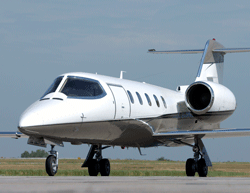Contributed by Randy Dill, RVSM GMU Flight Monitor

Most Learjet 35 models are not Mode S and require the RVSM minimum monitoring.
In a FAA Reduced Vertical Separation Minimum (RVSM) Notam dated March 9, 2011, aircraft of operators authorized to use RVSM airspace must conduct monitoring every two years or within 1,000 flight hours per aircraft, whichever period is longer. This requirement is a follow-up to the RVSM regulation implemented on January 20, 2005, in the United States and parts of Canada and Mexico. It became applicable on May 18, 2011, and operators have until November 18, 2012, to comply.
The majority of aircraft that fly in RVSM airspace, Flight Level 290 through Flight Level 410, must meet RVSM minimum monitoring requirements, meaning aircraft that fly within that airspace will be separated by a distance of 1,000 feet. To accomplish this, aircraft are monitored to ensure the equipment on the aircraft (FMS, autopilot, etc.), keep the aircraft at their respective assigned altitudes.
RVSM Monitoring Methods
If the aircraft is Mode S, it can fly over ground-based stations (AGHME) and have their altitude recorded and then published to the FAA RVSM website. There is no cost to the operator for this method of monitoring; however, they will not receive any form of documentation of the results.
Mode C aircraft, or Mode S if the operator prefers, must be monitored by a qualified technician using a GMU (GPS-Based Monitoring Unit) while aboard the aircraft. They track the altitude for a minimum of 30 minutes while flying at altitude. Both the customer and their local FAA representatives receive physical data from these flights, as well as the results being published on the FAA website.
Duncan Aviation has been monitoring RVSM aircraft since 2004. Many of the aircraft we’ve monitored are now due to be retested before the November deadline. More information on regulatory Requirements for RVSM Maintenance is available in the Duncan Aviation Intelligence Newsletter.
For more information about scheduling your aircraft RVSM Flight Monitoring, contact:
Battle Creek, Michigan (BTL)
- Adrian Chene, Avionics Installation Tech Rep
- Patrick Mapes, Assistant Manager Avionics Install
Lincoln, Nebraska (LNK)
- Eric Caler, RVSM GMU Flight Monitor / Scheduler
- Randy Dill, RVSM GMU Flight Monitor
- Rich Kempston, Assistant Manager Avionics Install
Randy Dill is a qualified RVSM GMU Flight Monitor and a CNC Fabrications Specialist at Duncan Aviation's Lincoln, Neb., facility. He specializes in manufacturing custom aircraft parts. His aviation career began in 1986.


